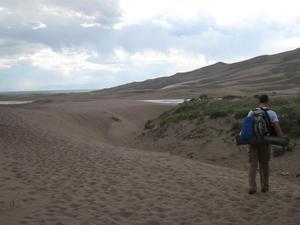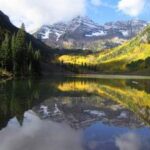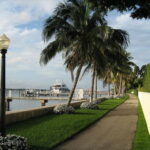The Great Sand Dunes National Park and Preserve is located near Alamosa, Colorado, and is focused on the titular dunes, the highest in North America. The dunes make up 30 square miles of sand, seemingly out-of-place in the Colorado landscape. Backpacking on the dunes offers a unique but accessible camping experience, especially in comparison to other overnight trips at public campgrounds. The camper who has visited other national parks will probably be used to designated campsites and staying on trails, but the dune field in this park has no designated campsites or trails. A backpacker can walk anywhere he’d like and camp anywhere he’d like. The largest animal is a type of mouse. Once you are a decent distance out onto the dunes, you’re unlikely to see anyone else. The solitude and freedom make it a memorable journey.
Preparation
This article assumes you have a basic knowledge of camping & outdoors safety, and it is also specific to dunes camping, not the other campsites in the park. Pack as you would for a normal overnight backpacking trip, with these tips: It will get chilly at night, so bring layers to dress in. A gallon of water per person per day is recommended. Fires are prohibited while camp stoves are allowed. Binoculars will be great for stargazing. Sand will get in everything, especially electronics – consider not bringing any. The second picture in this article is the last one the camera took before sand broke it! It is a carry in/carry out park, so you can’t leave any trash including toilet paper. (Don’t expect to find any porta-potties either.)
Dune hiking feels different from regular hiking. It’s harder, as the sand shifts under your feet. Hiking barefoot is nice, but during the heat of the day the sand will be scorchingly hot. Meanwhile your shoes will be buried under six inches of loose sand when you descend a dune. So, hiking in the evenings and mornings is recommended. It is simple to leave in the late afternoon, camp out, and return in the morning, never having dealt with the heat of day. Sand will be blowing around at times, especially the afternoon. The winds can be quite strong. Finally, the dunes are at a high altitude, and those from lower altitudes may find themselves winded much faster. Be ready to take a lot of breaks, and remember that you don’t have to make it to any specific campsite.
The Hike
You must pick up a backcountry permit before heading out. The ranger will give you some tips, explain the very minimal restrictions on where you camp, and tell you where to park. Gear up, and find a trailhead for the short hike out to the dunes themselves. Look at the mountains behind you – they’re a simple landmark to head towards when you’re on the way back. The trail heads through cactus and scrub towards the dunes.
The end of the trail and the start of the dunes is marked by Medano Creek, where, depending on the water level, you’ll probably have to take off your shoes, roll up your pants, and ford the river Oregon Trail-style. If the sand is cool enough to walk on, you can leave your shoes off for the rest of the trip.
Once across the creek, you’re at the dunes. The first climb, to the highest ridgeline you see from the trail or creek, is the hardest. It’s much easier to take a somewhat circuitous route, climbing the more gentle ridgelines, than to head straight up a steep dune. That first big ridgeline will take forever to reach, but once over it, you’re rewarded by a good view, and by being enclosed by the dunes. On my trip I never encountered anyone else past this boundary.
Now you can hike anywhere you wish, up and down the dunes. Descending is interesting. Your feet usually fall beneath a few inches of sand, and you leave a huge trail as displaced sand rolls down the dune.
Sometime before sunset, you should find a relatively flat place to make camp. The sunset on the dunes is spectacular. After sunset, eat your dinner and wait for the stars to come out. With no light pollution, the sky was practically glowing. The black dunes silhouetted against the stars provide excellent scenery – much better than I expected at night. Walking around with a flashlight is also interesting. The trails you see are probably left by bugs, which you should also see eventually. You probably don’t want to stay up too late, since it’s better to leave early in the morning.
The hike out is easier than the hike in. The dunes won’t have shifted overnight, but in any case you can simply head back towards the mountains. Hopefully you will be out of the dunes before the sand gets too hot to walk on barefoot. Consider emerging from the dunes at a different point than you went in, and hiking back to your car along the Medano Creek, which is relaxing and a nice end to your dunes trip.








